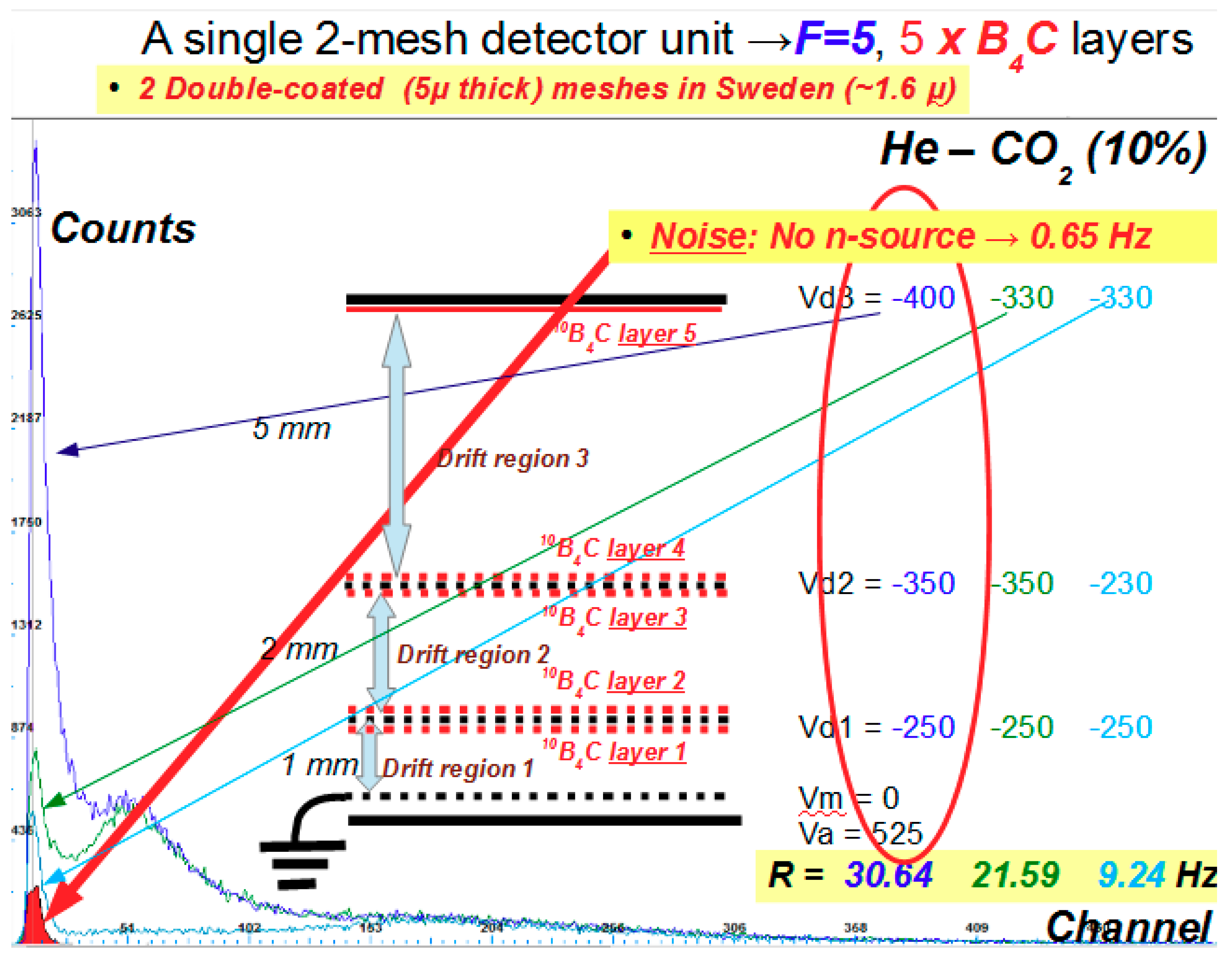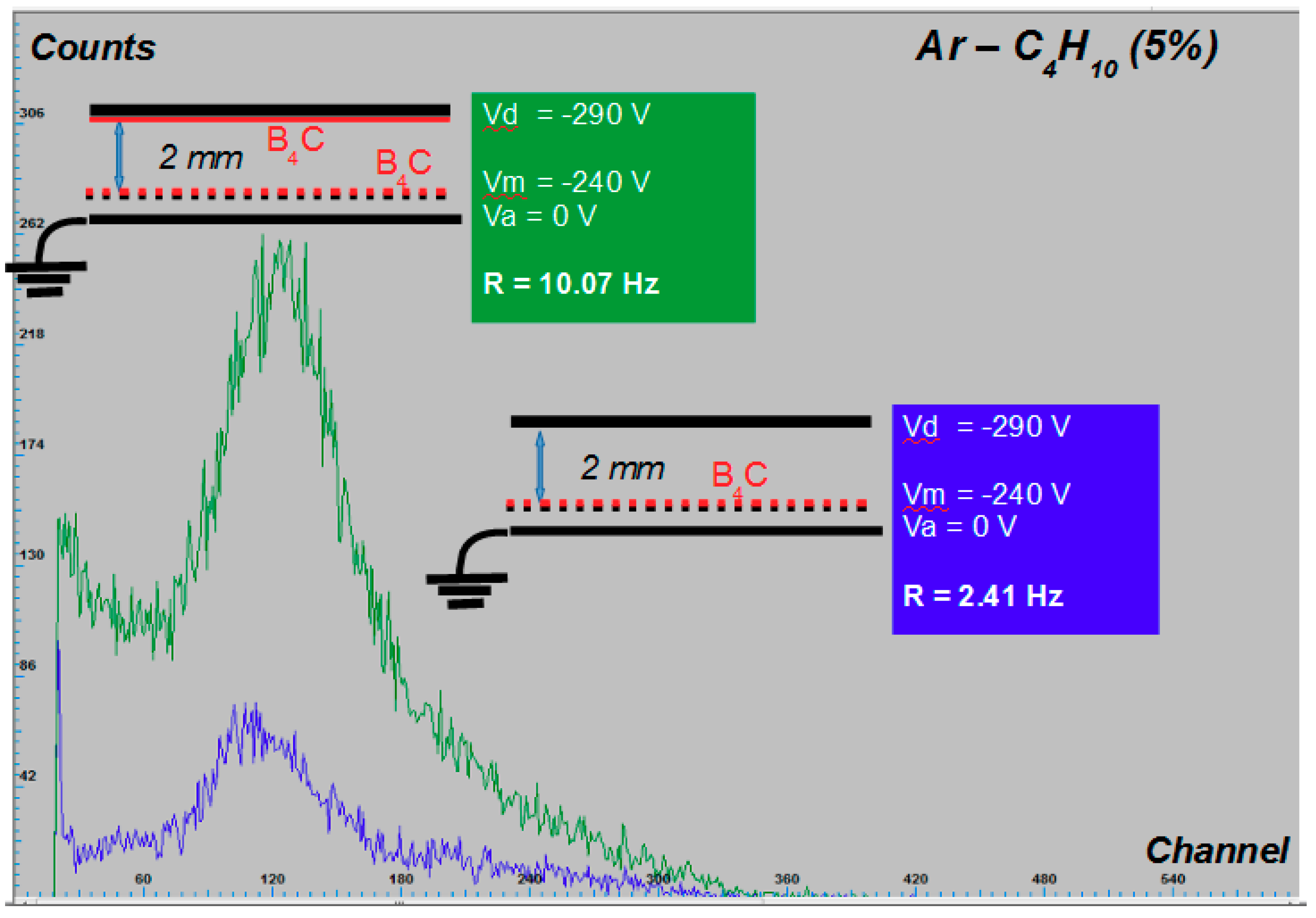Large High-Efficiency Thermal Neutron Detectors Based on the Micromegas Technology
Abstract
:1. Introduction
2. Simulations to Evaluate Electric Fields and Thermal Neutron Detection Efficiencies
3. A Prototype Design: Construction and Tests
4. Using the Microbulk Technology
5. Conclusions
Author Contributions
Funding
Acknowledgments
Conflicts of Interest
References
- Andersen, K.; Bigault, T.; Birch, J.; Buffet, J.C.; Correa, J.; Hall-Wilton, R.; Hultman, L.; Höglund, C.; Guérard, B.; et al. 10B multi-grid proportional gas counters for large area thermal neutron detectors. Nucl. Instrum. Meth. A 2013, 720, 116–121. [Google Scholar] [CrossRef]
- Bigault, T.; Birch, J.; Buffet, J.C.; Correa, J.; Hall-Wilton, R.; Hultman, L.; Hoglund, C.; Guerard, B.; Khaplanov, A.; Poscitelli, F.; et al. 10B multi-grid proportional gas counters for large area thermal neutron detectors. Neutron News 2012, 23, 20–24. [Google Scholar] [CrossRef]
- Höglund, C.; Birch, J.; Andersen, K.; Bigault, T.; Buffet, Je.; Correa, J.; van Esch, P.; Guerard, B.; Hall-Wilton, R.; Jensen, J.; Khaplanov, A.; et al. B4C thin films for neutron detection. J. Appl. Phys. 2012, 111, 104908. [Google Scholar] [CrossRef]
- Höglund, C.; Zeitelhack, K.; Kudejova, P.; Jensen, J.; Greczynski, G.; Lu, J.; Hultman, L.; Birch, J.; Hall-Wilton, R. Stability of 10B4C thin films under neutron radiation. J. Radiat. Phys. Chem. 2015, 113, 14–19. [Google Scholar] [CrossRef]
- Schmidt, S.; Höglund, C.; Jensen, J.; Hultman, L.; Birch, J.; Hall-Wilton, R. Low Temperature Growth of Boron Carbide Coatings by Direct Current Magnetron Sputtering and High Power Impulse Magnetron Sputtering. J. Mater. Sci. 2016, 51, 10418–10428. [Google Scholar] [CrossRef]
- Nowak, G.; Störmer, M.; Becker, H.-W.; Horstmann, C.; Kampmann, R.; Höche, D.; Haese-Seiller, M.; Moulin, J.-F.; Pomm, M.; Randau, C.; Lorenz, U.; et al. Boron carbide coatings for neutron detection probed by x-rays, ions, and neutrons to determine thin film quality. J. Appl. Phys. 2015, 117, 034901. [Google Scholar] [CrossRef] [Green Version]
- Goddard, B.; Charlton, W.; Peerani, P. First principle active neutron coincidence counting measurements of uranium oxide. Nucl. Instrum. Meth. A 2014, 739, 1–5. [Google Scholar] [CrossRef]
- Summary Based on Presentations during RD51; RD51-NOTE-2014-003; Accademia-Industry Matching Event, 14–15 October 2013; CERN: Genève, Switzerland, 2013.
- Giomataris, Y.; Rebourgeard, P.; Robert, J.P.; Charpak, G. MicrOMEGAs: A High granularity position sensitive gaseous detector for high particle flux environments. Nucl. Instrum. Meth. A 1996, 376, 29. [Google Scholar] [CrossRef]
- Delbart, A.; Menelle, A. Expressions of Interest Concerning LLB & IRFU Contributions to Large Scale 10B Neutron Detectors; 2 Expressions of Interest Submitted to ESS in August 2013; ESS: New Delhi, India, 2013.
- Tsiledakis, G.; Delbart, A.; Desforge, D.; Giomataris, I.; Menelle, A.; Papaevangelou, T. A large high-efficiency multi-layered Micromegas thermal neutron detector. J. Instrum. 2017, 12, P09006. [Google Scholar] [CrossRef]
- COMSOL Multiphysics User’s Guide, Version 4.3; COMSOL AB: Stockholm, Sweden, 2012.
- Veenhof, R. GARFIELD, recent developments. Nucl. Instrum. Meth. A 1998, 419, 726. [Google Scholar] [CrossRef]
- Majumdar, N.; Mukhopadhyay, S. Simulation of three dimensional electrostatic field configuration in wire chambers: A Novel approach. Nucl. Instrum. Meth. A 2006, 566, 489. [Google Scholar] [CrossRef]
- Mukhopadhyay, S.; Majumdar, N.; Bhattacharya, S. Electrostatics of micromesh based detectors. J. Instrum. 2009, 4, P11004. [Google Scholar] [CrossRef]
- Battistoni, G.; Cerutti, F.; Fassò, A.; Ferrari, A.; Muraro, S.; Ranft, J.; Roesler, S.; Sala, P.R. The FLUKA code: Description and benchmarking. AIP Conf. Proc. 2007, 896, 31. [Google Scholar] [CrossRef]
- Fasso, A.; Sala, P.R.; Fasso, A.; Ranft, J. FLUKA: A Multi-Particle Transport Code. CERN-2005-10, 2005. INFN/TC_05/11, SLAC-R-773A. Program Version 2011. Available online: http://www.fluka.org/content/manuals/FM.pdf (accessed on 6 January 2014).
- Tsiledakis, G.; Delbart, A.; Desforge, D.; Giomataris, Y.; Gunsing, F.; Papaevangelou, T.; Peyaud, A. A Large High-Efficiency Multi-Layers Micromegas Thermal Neutron Detector, International Workshop on Position Sensitive Neutron Detectors (PSND 2014). Available online: https://www.dropbox.com/s/2ec89ws2m77uuh2/GTsiledakisMeetAachen.pdf?dl=0 (accessed on 4 June 2014).
- Abgrall, N.; Blondel, A.; Cadoux, F.; Di Marco, M.; Ferrere, D.; Ferrero, A.; Masciocchi, F.; Perrin, E.; Ravonel Salzgeber, M.; Schroeter, R.; et al. Time Projection Chambers for the T2K Near Detectors. Nucl. Instrum. Meth. A 2011, 637, 25–46. [Google Scholar] [CrossRef]
- Belloni, F.; Gunsing, F.; Papaevangelou, T. MicrOMEGAs for neutron detection and imaging. Mod. Phys. Lett. A 2013, 28, 1340023. [Google Scholar] [CrossRef]
- Papaevangelou, T.; Alves, H.; Aune, S.; Beltramelli, J.; Bertrand, Q.; Bey, T.; Chauvin, N.; Desforge, D.; Desmons, M.; Desmons, Y.; et al. ESS nBLM: Beam Loss Monitors based on Fast Neutron Detection. In Proceedings of the 61st ICFA Advanced Beam Dynamics Workshop on High-Intensity and High-Brightness Hadron Beams, Daejeon, Korea, 17–22 June 2018. THA1WE04. [Google Scholar] [CrossRef]
- Aune, S.; Brauninger, H.; Dafni, T.; Fanourakis, G.; Ferrer-Ribas, E.; Lacarra, J.G.; Geralis, T.; Giomataris, I.; Iguaz, F.; Irastorza, I.G.; et al. New MicrOMEGAs detectors in the CAST experiment. Nucl. Instrum. Meth. A 2009, 604, 15–19. [Google Scholar] [CrossRef]
- Dafni, T.; Ferrer-Ribas, E.; Giomataris, I.; Gorodetzky, P.; Iguaz, F.; Irastorza, I.G.; Salin, P.; Tomas, A. Energy resolution of alpha particles in a microbulk Microme gas detector at high pressure Argon and Xenon mixtures. Nucl. Instrum. Meth. A 2009, 608, 259. [Google Scholar] [CrossRef]
- Tomas, A.; Cebrián, S.; Dafni, T.; Ferrer-Ribas, E.; Galán, J.; Giomataris, I.; Gómez, H.; Gorodetzky, P.; Iguaz, F.J.; Irastorza, I.G.; et al. Development of MicrOMEGAs for neutrinoless double beta decay searches. J. Instrum. 2009, 4, P11016. [Google Scholar] [CrossRef]
- Andriamonje, S.; Attie, D.; Berthoumieux, E.; Calviani, M.; Colas, P.; Dafni, T.; Fanourakis, G.; Ferrer-Ribas, E.; Galan, J.; Geralis, T.; et al. Development and performance of Microbulk Micromegas detectors. J. Instrum. 2010, 5, P02001. [Google Scholar] [CrossRef]
- Sauli, F. GEM: A new concept for electron amplification in gas detectors. Nucl. Instrum. Meth. A 1997, 386, 531. [Google Scholar] [CrossRef]
- Sauli, F. Development and applications of gas electron multiplier detectors. Nucl. Instrum. Meth. A 2003, 505, 195. [Google Scholar] [CrossRef]






© 2018 by the authors. Licensee MDPI, Basel, Switzerland. This article is an open access article distributed under the terms and conditions of the Creative Commons Attribution (CC BY) license (http://creativecommons.org/licenses/by/4.0/).
Share and Cite
Tsiledakis, G.; Delbart, A.; Desforge, D.; Giomataris, I.; Papaevangelou, T.; Hall-Wilton, R.; Höglund, C.; Robinson, L.; Schmidt, S.; Menelle, A.; et al. Large High-Efficiency Thermal Neutron Detectors Based on the Micromegas Technology. Universe 2018, 4, 134. https://doi.org/10.3390/universe4120134
Tsiledakis G, Delbart A, Desforge D, Giomataris I, Papaevangelou T, Hall-Wilton R, Höglund C, Robinson L, Schmidt S, Menelle A, et al. Large High-Efficiency Thermal Neutron Detectors Based on the Micromegas Technology. Universe. 2018; 4(12):134. https://doi.org/10.3390/universe4120134
Chicago/Turabian StyleTsiledakis, Georgios, Alain Delbart, Daniel Desforge, Ioanis Giomataris, Thomas Papaevangelou, Richard Hall-Wilton, Carina Höglund, Linda Robinson, Susann Schmidt, Alain Menelle, and et al. 2018. "Large High-Efficiency Thermal Neutron Detectors Based on the Micromegas Technology" Universe 4, no. 12: 134. https://doi.org/10.3390/universe4120134




